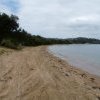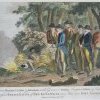Capture of Arabanoo, a Kayeemaigal man, at Manly Cove, and on Governor Phillip’s orders.
The boats proceeded to Manly Cove, where several Indians were seen standing on the beach, who were enticed by courteous behavior and a few presents to enter into conversation. A proper opportunity being presented, our people rushed in among them, and seized two men. The rest fled, but the cries of the captives soon brought them back, with many others to their rescue … only one of them was secured; the other effected his escape … an attack from the shore instantly commenced.
In talking about Arabanoo, Marine Captain Watkin Tench writes “Indeed the gentleness and humanity of his disposition frequently displayed themselves … When our children … used to flock around him, he never failed to fondle them.” (Tench 1996, p. 95)
In the same year,
A journey of explorationis undertaken to Broken Bay and the Hawkesbury River, and survey of Broken Bay.
William Bradley’s painting depicts Pittwater from Bayview. In this image there are English soldiers shaking hands and dancing with Koories. There are ten canoes with Koories fishing, while others crowd around the shores in an apparently harmonious meeting. On many occasions Phillip and his officers present gifts such as mirrors, clothes and hatchets to the Koories. (Bradley 1969)
Bennelong (A Wangal man) and Colbee (Cadigal) are captured at Manly.
Koori people have no resistance to European diseases; some die even due to the common cold.
A smallpox epidemic devastates Indigenous population around Sydney. Bodies of are washed up on the shores of the harbour. In a journey to Broken Bay, Phillip on 6 June writes
In many places our path was covered with skeletons and the same spectacle were to be met with in hollows of most of the rocks of that harbour”. Captain Hunter saw at Broken Bay “a native girl … just recovered from small pox, and lame, she appeared to be 17 or 18 years of age, and had covered her debilitated and naked body with wet grass … she was very much frightened on our approaching her and shed many tears … we soothed her distress a little, and the sailors were ordered to bring up some fire for her.
In a second expedition (to Broken Bay) ”the river received the name Hawkesbury … natives were found labouring under small pox. They did not attempt to commit hostilities against the boats” (Tench 1996, p. 110)
.thumbnail.jpg)

